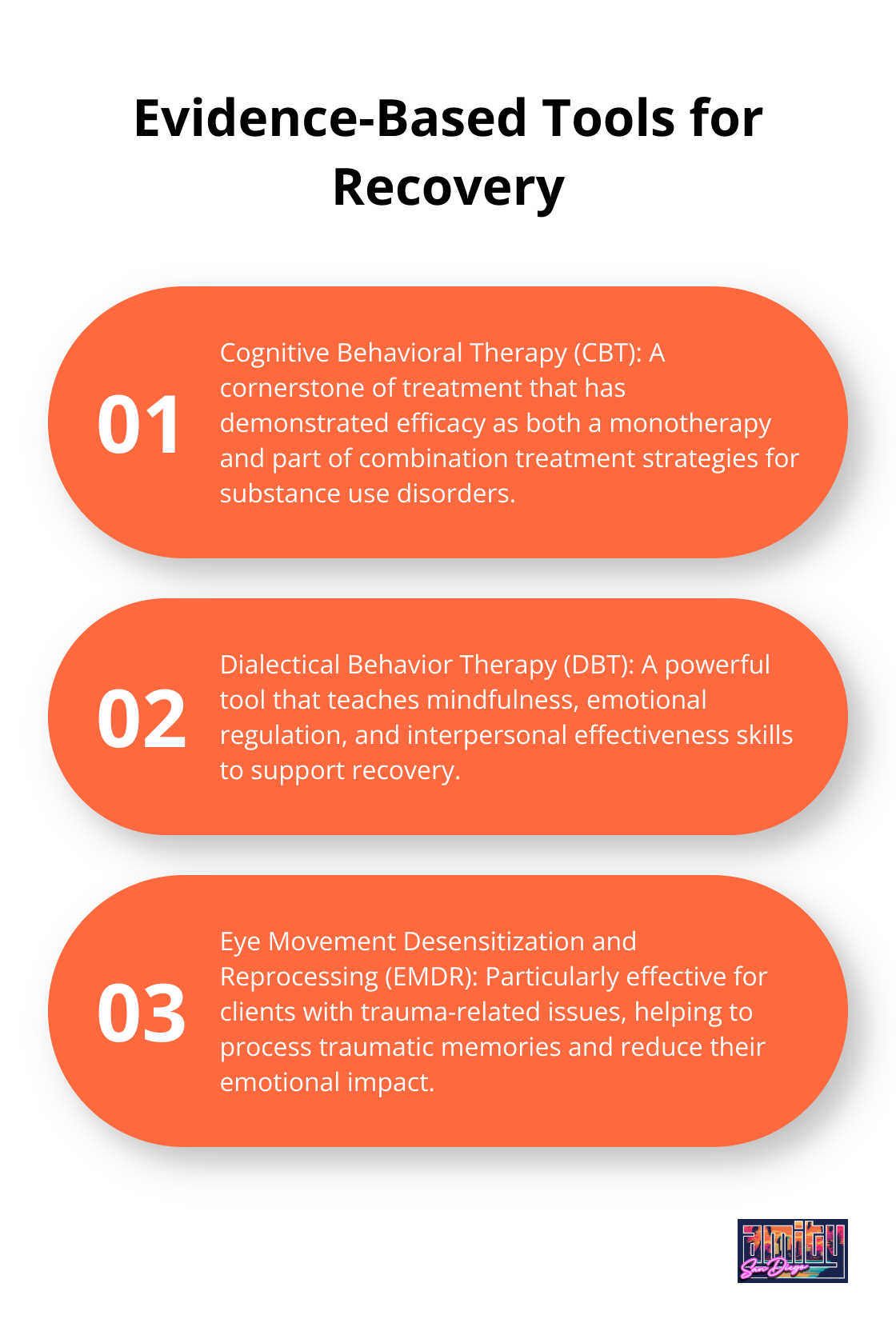At Amity San Diego, we understand that recovery is a deeply personal journey. The healing process is unique for each individual, shaped by their experiences, challenges, and strengths.
This guide explores the stages of personal healing, effective tools for recovery, and strategies to overcome common obstacles. We aim to provide you with practical insights to support your path towards lasting wellness and sobriety.
Stages of Personal Healing in Recovery
Recognizing the Need for Change
The journey to recovery begins with a critical first step: acknowledging the problem. This stage involves breaking through denial and accepting the reality of addiction. Individuals often experience a mix of emotions, including fear, shame, and relief.
The National Institute on Drugs and Addiction (formerly known as the National Institute on Drug Abuse) plays a crucial role in addressing substance use disorders (SUDs) and providing treatment resources.
Physical Restoration and Detoxification
After the decision to seek help, the focus shifts to physical healing. Detoxification (often called “detox”) is a crucial step in this process. The duration of detox varies from a few days to several weeks, depending on the substance and individual factors.
During this time, the body rids itself of toxins, often resulting in withdrawal symptoms. It’s important to note that detox marks the beginning of the healing process, not the end goal.
Emotional Healing and Mental Health
As physical symptoms subside, emotional and psychological issues often come to the forefront. This stage involves addressing underlying mental health concerns, trauma, and developing healthy coping mechanisms.
Evidence-based therapies like Cognitive Behavioral Therapy (CBT) and Dialectical Behavior Therapy (DBT) help clients process emotions and develop new thought patterns. CBT for AOD (Alcohol and Other Drugs) is a well-established intervention with demonstrated efficacy, although effect sizes are in the small-to-moderate range. A dual diagnosis approach ensures that co-occurring mental health issues are treated alongside addiction.
Rebuilding Relationships and Trust
The final stage of healing focuses on repairing damaged relationships and rebuilding trust with loved ones. This process requires patience, open communication, and a willingness to make amends.
Family involvement in treatment (through therapy sessions and educational programs) can significantly improve outcomes. Research suggests that family involvement across the continuum of substance use disorder (SUD) treatment is important for improving outcomes.
Navigating the Non-Linear Path
Healing doesn’t follow a straight line. It’s common to move back and forth between these stages. What matters most is maintaining momentum and seeking support when needed.
The journey through these stages is unique for each individual. Some may progress quickly, while others need more time in certain phases. Recognizing this variability helps set realistic expectations and fosters self-compassion throughout the recovery process.
As we explore the tools and techniques that facilitate healing in the next section, keep in mind that each person’s path to recovery is distinct. The key lies in finding the right combination of strategies that resonate with your individual needs and experiences.
[A hub and spoke diagram showing the stages of personal healing in recovery: recognizing the need for change, physical restoration and detoxification, emotional healing and mental health, rebuilding relationships and trust, and navigating the non-linear path.]Effective Tools for Recovery Success
At Amity San Diego, we use a variety of evidence-based tools and techniques to support our clients’ healing journeys. Our approach combines proven therapies with holistic practices, creating a comprehensive treatment plan tailored to each individual’s needs.

Evidence-Based Therapies
Cognitive Behavioral Therapy (CBT) forms a cornerstone of our treatment program. This approach has demonstrated efficacy as both a monotherapy and as part of combination treatment strategies for substance use disorders.
Dialectical Behavior Therapy (DBT) is another powerful tool we employ. DBT teaches mindfulness, emotional regulation, and interpersonal effectiveness skills.
Eye Movement Desensitization and Reprocessing (EMDR) proves particularly effective for clients with trauma-related issues. This therapy helps process traumatic memories and reduce their emotional impact.
Holistic Approaches
We integrate holistic practices into our treatment plans to address the whole person. Holistic interventions have shown effectiveness in reducing cravings, decreasing the frequency of use, and improving outcomes for individuals with substance use disorders.
Yoga is another valuable tool in our program. Regular yoga practice can reduce stress, improve mood, and increase body awareness.
Nutrition plays an important role in recovery. We provide nutritional counseling to help clients repair the physical damage caused by substance use and establish healthy eating habits.
Peer Support and Group Therapy
Group therapy and peer support are integral components of our treatment approach. These sessions provide a sense of community and allow clients to learn from others’ experiences.
Medication-Assisted Treatment (MAT)
For some clients, Medication-Assisted Treatment (MAT) can be an effective tool in recovery. MAT combines behavioral therapy with FDA-approved medications to treat substance use disorders.
Our approach at Amity San Diego uses a combination of these tools and techniques to create a personalized treatment plan for each client. We remain flexible and adaptable, ensuring that we meet the unique needs of every individual on their journey to recovery. As we move forward, it’s essential to address the challenges that often arise during the healing process (which we’ll explore in the next section).
Navigating Recovery Hurdles
The path to recovery presents challenges, but with effective strategies and support, you can overcome obstacles. At Amity San Diego, we’ve witnessed individuals triumph over seemingly insurmountable hurdles. Let’s explore common challenges and practical ways to address them.
[A checkmark list chart presenting five strategies for navigating common recovery hurdles: managing cravings, addressing co-occurring mental health issues, reshaping social environment, confronting past trauma, and seeking professional support.]Taming Cravings and Triggers
Cravings and triggers pose formidable opponents in recovery. To combat these urges:
- Identify your personal triggers (people, places, emotions)
- Create a craving management plan (distraction techniques, support calls)
- Practice mindfulness to observe cravings without acting on them
- Use cognitive restructuring to challenge thoughts leading to cravings
Many clients find success with the “urge surfing” technique. This involves visualization of cravings as waves that rise, peak, and eventually subside.
Addressing Co-occurring Mental Health Issues
Approximately 21.5 million adults in the U.S. have co-occurring disorders (according to the Substance Abuse and Mental Health Services Administration). Management of these issues alongside addiction recovery is essential. We recommend:
- Seek integrated treatment that addresses both addiction and mental health
- Stay consistent with prescribed medications
- Engage in therapies like CBT or DBT that target both issues
- Build a strong support network that understands dual diagnosis
Reshaping Your Social Environment
Your social circle can significantly impact your recovery. A study in the Journal of Studies on Alcohol and Drugs found that individuals with a higher percentage of non-drinking friends in their social network were more likely to remain abstinent.
- Evaluate your current relationships and their impact on your recovery
- Seek out recovery-supportive social groups or activities
- Learn to set boundaries with people who may jeopardize your progress
- Consider sober living arrangements during early recovery
Confronting Past Trauma
Unresolved trauma often fuels addiction. The Adverse Childhood Experiences (ACE) study revealed a strong link between childhood trauma and substance use disorders in adulthood. To address this:
- Engage in trauma-informed therapies (like EMDR or Seeking Safety)
- Practice self-compassion and forgiveness exercises
- Use journaling or expressive arts to process emotions
- Gradually expose yourself to trauma reminders in a safe, therapeutic setting
Healing from trauma takes time. Be patient with yourself and celebrate small victories along the way.
Final Thoughts
The healing process in recovery requires patience, perseverance, and support. At Amity San Diego, we combine evidence-based therapies with holistic practices to address addiction and co-occurring mental health issues. Our experienced team equips clients with the skills and strategies needed to maintain long-term sobriety.
Professional support plays a vital role in recovery success. We offer comprehensive outpatient programs, including Partial Hospitalization (PHP) and Intensive Outpatient (IOP) services, tailored to meet individual needs. Our approach fosters lasting recovery through personalized care in a safe, nurturing environment.
You don’t have to face addiction alone. Amity San Diego guides individuals through every step of their recovery journey (with compassion and clinical excellence). Your path to healing and renewed purpose starts here.

